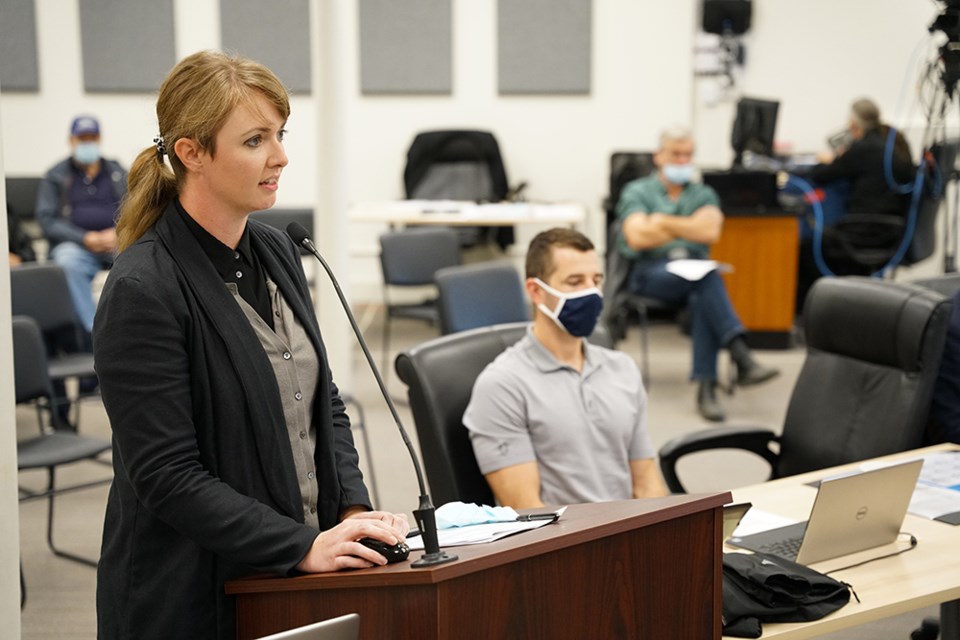City of Powell River council received an overview of the phase one community engagement summary report on the sustainable official community plan Townsite neighbourhood review.
At the October 5 committee of the whole meeting, senior planner Daniella Fergusson appeared before councillors to provide an update about the review process.
“We are doing a three-phase community engagement process to update the sustainable official community plan (SOCP) land use designation, for about 230 acres of city-owned land in Townsite,” said Fergusson. “We are currently in phase two. The purpose of my presentation is to summarize some of the findings we heard in phase one and tell you about how we are engaging people in phase two.”
Fergusson said in the first phase, city staff did quite a bit of online engagement, and then provincial health orders loosened, so the city was able to host in-person engagement.
“We hosted some online question and answer sessions in June and July,” said Fergusson. “We attended some community meetings with the Townsite Ratepayers Society and the Townsite Ratepayers Association. We had a drop-in open house in July. We met with some neighbouring landowners and stakeholders. We also met with the ministry of transportation and infrastructure. We also gave a presentation to Tla’amin Nation’s executive council.
“Through all of that engagement, altogether, we got hundreds of comments, which are summarized in the phase one engagement report.”
Fergusson said out of all those comments, the vast majority were on parks and trails, then housing was the next large portion. She said this makes sense because there has been a discussion about a housing needs assessment. The remaining comments focused on the existing industrial usage, agriculture, the need to protect the natural environment, plus other thoughts.
“Something we heard loud and clear in phase one was that trails are really valued parts of this area, not only for people to get into nature, but also connecting people through active transportation means to the rest of the community,” said Fergusson.
She said for the agricultural lands, the city did not get a lot of comments, but those received indicated the lands should be kept agricultural, and that people value the greenspace. It was also indicated that if agriculture was taking place, it should be community level and supported agriculture, or something that builds the food system and where people can learn about food and farming.
More topics
The next topic was that the lower Millennium Park should remain a park and that there are important ecological services provided by this land, as well as cultural and other resources, said Fergusson.
“Staff are recommending this stay as great greenspace in the middle of our city and a place where we have those amazing trail connections,” said Fergusson.
She said the trails that go from Millennium Park into Townsite are highly valued and there is an existing green buffer around Townsite in the official community plan.
Another big theme was First Beach, which is federal land, but the city has upland access to it.
“We heard from people that they love that beach and would like to see pedestrian access to it, as well as vehicle access, which is something we’ll have to figure out,” said Fergusson.
She outlined the log dump in Townsite and said meetings had been held with Western Forest Products and others, and the city heard loud and clear that this is an important part of the community. She said the haul road is active, with many trucks using it on a daily basis, with special attention to using it at specific times of the day so people can still access First Beach.
“Active logging operation is going to continue in the future, and although not everyone in the community agrees, Western Forest Products has a legal right to use that road and that land so that will be something that continues moving forward,” said Fergusson.
The shoreline was also a consideration, and maintaining public access was important. Suggestions included a sea walk or extending the Willingdon Beach trail across the waterfront, according to Fergusson.
Phase two
In putting the whole plan together, Fergusson said there are some areas that have community and stakeholder direction, but some areas require more clarity, so in phase two, the city will be honing into those areas. Areas include lands adjacent to the resource-recovery centre, and places where housing could conceivably be built.
Fergusson said the city has planned further events for public engagement. On October 13 and 14 at Dwight Hall, from 4 to 6 pm, there is some limited capacity because it will be workshop-style engagement. She said she would outline phase one and then participants would sit down in small groups with the city’s planning team to dive more deeply into some focus areas.
Fergusson said once all feedback from phase two has been received, some draft SOCP objectives and policy language will be put together, as well as a new map with land uses. She said that when the meeting was held with Tla’amin’s executive council, they stated that an archaeological overview assessment would be an important step. According to Fergusson, this would push the timeline out.
“It seems like a very sensible request,” said Ferguson. “If there are archaeological places that should not be disturbed, we should not be marking those areas as suitable for development through the SOCP.”
Councillor George Doubt said he agreed that an archaeological investigation of the whole site is a good idea. He said his concern is that it might take a significant amount of time and change the timeline for approval of the plan, but he said it’s something that needs to be done.
Committee chair councillor Rob Southcott asked how long the archaeological study would take. Fergusson said it is expected to add a six-week delay.
The committee voted for council to receive the report for information.



